Providing an Incentive: Developing Publishing Services for Researchers: The Session Blog
Presenter: Sara Fuchs, Digital Initiatives Library, Department of Scholarly Communication & Digital Services, Georgia Institute of Technology
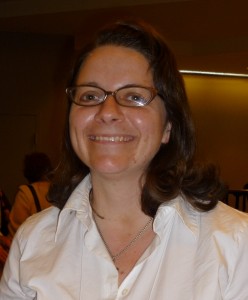
Sara Fuchs
Time: 4-5pm, July 9th, 2009
Place: SFU Harbour Centre, Sauder Industries Room 2270
———————————————————————————————
Session Overview
Background
The Georgia Tech Library Department of Scholarly Communication & Digital Services set up an institutional repository in 2004 in hopes that faculty members could self-submit. Although they had always had a repository, it was usually set up after conferences had occurred. The department later decided to provide more support and began to help faculty create, store and view their papers, especially since nobody else on campus was offering similar services. The service provides both conference and journal support, as well as the uploading of any video recordings (of lectures as well), and digital archiving on the centralized repository for Georgia Tech authored materials, known as SMARTech. Submission onto SMARTech requires that the authors grant a non-exclusive license to Georgia Tech for non-commercial uses– mainly to raise awareness about open access to graduate students and supporting scholarly collaboration. SMARTech is now one of the largest institutional repositories in the United States and 35th in the world according to the Ranking Web of World Repositories, a project by the Spanish public research body Consejo Superior de Investigaciones Científicas (CSIC).
Lessons Learned with Open Conference Systems (OCS)
OCS works well for what it is supposed to do. It was a low pressure situation for the department because there was no need to maintain the OCS software, as everything was eventually going to end up in the repository. They found that clients enjoyed using OCS much more than the normal email workflow.
However, there were still challenges. With OCS, the process of accepting and rejecting proposals was more difficult– conference calls seemed to be much easier, and there is always a time lag in uploading presentations. Another challenge surfaced while setting up the Open Repositories 2009 Conference, mainly because they were working with two different websites. It made it very difficult to collect and retrieve conference papers. The Access Services Conference was the first time the payment function of OCS was used. Again, it was difficult to synchronize across two websites and this required going through multiple steps.
Customization
Clients wanted something more slick and streamlined, and wanted to use the more interactive parts of OCS, such as giving comments directly to authors, etc. In order to do this, all .css and template files had to be modified. New headers needed to be created, as well as modification of some menus, journal layout, and downloading of specific plug-ins. This proved to be very time-consuming, and this took design changes out of the hands of journal managers/editors. That being said, clients were highly satisfied and this became a showpiece of the department’s collaboration with faculty.
Questions
(Ran out of time)
Comment: Some of the difficulty in syncing between two websites might be easier if you upload/download directly from OCS instead of another location.
Related Links
July 13, 2009 Comments Off on Providing an Incentive: Developing Publishing Services for Researchers: The Session Blog
Importing Backissues into OJS: Development of an OJS Import Script with Django: the Session Blog
Presenter: Syd Weidman, Library Systems Supervisor, University of Winnipeg – Session Abstract
Session Overview
Why was this an issue?
With the transition to open-access publishing of several journals at the University of Winnipeg, Syd Weidman and the University library have been involved in multiple aspects of this transformation. Given that these journals have been in print for decades, one of the major obstacles that needed to be addressed was the importation of back issues into an online, open-access compatible format.
Initial attempts using the available software proved difficult. They were met with bugs and their associated patches; overall, Syd described the process as “laborious and convoluted”. He surmised that “in the context of importing [a large volume of] back issues, small efficiencies [may] have a large impact.” With this notion in mind, Syd began work on the Open Journal Systems (OJS) Import Project.
Tackling the problem – Use of Django
Syd highlighted the basic design goals of any software to be used for this purpose; he stressed that the process needed to be as EASY as possible. He sought to optimize the software’s ease of CONSTRUCTION, USE, DEPLOYMENT and MAINTENANCE. Being most familiar and comfortable with the Python programming language, Syd opted to use the Django Web framework to build a Web-based application to carry out the task of importing back issues.
Django is an open-source framework that was initially used by the online publishing industry. With a short digression, Syd took a moment to review the “4 freedoms” of open-source software, being the “free” use of software for any purpose, free access to its code, freedom to modify as well as an understanding that improvements will be shared with others (for more, take a look at the Free Software Foundation’s website.) Django, in particular, has several advantages over other similar frameworks, namely:
- object relational mapping – allows use of fewer lines of programming, increasing robustness
- automatic administrator interface
- elegant URL design
- pluggable template system
- flexible and robust cache system
- i18n compatible – allows for the application to be adapted to other languages without significant engineering changes
- excellent documentation
- an active mailing list (a double-edged sword!)
Success!
With the development of the new importation software, the U of W was able to scan backissues into .pdf format, to ultimately be uploaded into their respective online journals. This required the entering of appropriate metadata in order to allow for accurate archiving and searching.
Challenges and future directions
One of the difficulties in developing a script for another piece of software is to ensure that they remain in sync when new versions appear. In a subsequent OJS release following the development of the OJS importing application, incompatibilities/bugs appeared, and needed patching.
Commentary/Questions
Just prior to the question period, Syd mentioned the recent development of another application, “Quick Submit”, which may now be able to perform similar functions to his program.
Related Links
University of Winnipeg library (and their OA publications: Canadian Bulletin of Medical History, Journal of Mennonite Studies and the Canadian Children’s Literature Journal) Python programming language Django frameworkReferences
Weidman, S. (2009). Importing backissues into ojs: development of an ojs import script with django. PKP Scholarly Publishing Conference 2009. Retrieved 2009-07-08, from http://pkp.sfu.ca/ocs/pkp/index.php/pkp2009/pkp2009/paper/view/190
July 11, 2009 Comments Off on Importing Backissues into OJS: Development of an OJS Import Script with Django: the Session Blog
Open Access and the Economics of Scholarly Communication: The Session Blog
Presenter: Heather Morrison, Project Co-ordinator, BC Electronic Library Network – Session abstract
Heather’s presentation was recorded. It’s available here.
Session Overview
In this session, Heather Morrison presented an overview of the economic environment in which scholarly publication currently exists, focusing her attention on potential effects of the growth of the Open Access (OA) movement on this environment.
The Macroeconomics of Scholarly Publishing
Heather began by framing her discussion with the modern definition of economics, that is, the study of our behavior and the means by which we achieve certain ends given limited resources. This was used to raise the following question: “Where is the money to help with the transition to fully OA publishing?”
The current economic situation was then explored with a description of the estimated costs of per-article publishing in the domains of science and technology. These estimates range widely from one publisher to the next;
- BMC – 1500$/article
- PLoS One – 1300$/article
- Springer Open Choice – 3000$/article
- Hindawi – 800$/article
These costs, among not-for-profit publishers, are broken down in the following way:

In the realm of highly profitable for-profit publishing, the per-article cost is broken down in the following manner (as per Heather Morrison’s research). Alarmingly, in this economic model, nearly 50% of the per-article revenue goes to profits and taxes. Perhaps most interestingly, she pointed to a number of examples where for-profit publishers charged from 6 to 7 times more for publications that were actually less cited than similar journals put out by not-for-profit publishers.

Alternative to the current model
Looking at these numbers allows an examination of costs that may be reduced through a transition to fully OA publishing and the introduction of a number of efficiencies. OA technology such as Open Journal Systems could offer the following benefits;
- reduction in the costs of coordinating the refereeing process
- elimination of typesetting and printing costs
- reduced systems and staffing costs
- elimination of authentication, hosting and troubleshooting costs
- dropping the need for copyright policing
Other less direct efficiencies introduced by the adoption of fully open-access publishing include a rethinking of the rejection process, with a reduction in the need to resubmit rejected articles to additional journals.
With these new efficiencies and cost savings, Heather suggests, libraries would have additional resources to allocate to building collections, rather than buying collections; to funding institutional repositories rather than spending on inter-library loans and to digitizing and preserving electronic collections rather than shelving print journals.
What if the subscription-based scholarly publishing industry were to collapse?
The concern has been raised by a number of publishers that the introduction of fully open access publication may threaten the viability of the current subscription-based model. Heather contends that although they are unlikely to fail any time soon, if the major publishers collapsed, there is sufficient open-access support available to help journals carry on with their publishing activities. She argues that this collapse (again, however unlikely) would provide an opportunity to rethink, renew and rebuild our publishing system.
Commentary
Not surprisingly, this presentation gave rise to a healthy amount of discussion. Questions were directed both to Heather Morrison and Frederick Friend who gave a talk on the future of scholarly publishing. The following questions were raised;
How would fully open-access publishing be cheaper than the subscription-based system? The savings are thought to come from the wresting of control of costs from the publishers into the hands of academics. In order for the savings to materialize, however, academics will need to focus on transforming several aspects of the economics of publishing.
If libraries are already struggling to cope with the rising costs of subscriptions, how can they set aside money for open-access initiatives? This will likely require a multi-faceted approach. Librarians will need to set priorities along with researchers in order to make decisions about which subscriptions are most needed. If needed, they may also need to consider canceling “one big deal” in order to leave room for OA funding.
Related links
Imaginary Journal of Poetic Economics – Heather Morrison’s BlogCanadian Libraries Association Position Statement on Open Access Scholarly Communication for Librarians – Heather’s new book
References
Morrison, H. (2009). Open access and the economics of scholarly communication. PKP Scholarly Publishing Conference 2009. Retrieved 2009-07-08, from http://pkp.sfu.ca/ocs/pkp/index.php/pkp2009/pkp2009/paper/view/136
July 11, 2009 Comments Off on Open Access and the Economics of Scholarly Communication: The Session Blog
Open Journal Systems (OJS) software as used by African Journals Online (AJOL) – The Session Blog
July 9, 2009 at 10:30 a.m. SFU Harbour Centre (remote session). Rm. 7000
Susan Murray (Source)
Background
Ms. Susan Murray is a proactive individual working with the African Journals Online (AJOL), a non-profit organization, as the executive director for over two years. Her she academic background is on development economics and she is focused on opening access to information in developing countries such as Africa.
Session Overview
Ms. Murray’s session is a journey from the 1990s to present day focusing on the progression of access to African Journals Online (AJOL) (Session Abstract). She begins with an overview of the journal, followed by the users and stakeholders involved, which she ties in to a comparison of the old and new systems along with the future outlook for AJOL, and finally she concludes the presentation with a business plan and parting remarks.
(1) Overview of AJOL
Ms. Susan Murray started the presentation with the following quote from Mamphela Ramphele :
“There is no way we can succeed in the eradication of poverty if the developing world is not part of knowledge creation, its dissemination and utilization to promote innovation. Higher education is a critical factor in making this possible and must be part of any development strategy.”
– Mamphela Ramphele (2000)
Ms. Murray goes on to explain the importance of higher education and policies governing such institutes. She indicates that there is a long way to go in terms of sharing and transferring knowledge to the developing worlds, however it must be done and there is harm in not doing so as innovation cannot advance in these developing countries. In Africa the process of dissemination has already begun with AJOL hoping to increase its visibility and accessibility of open journal sources. Currently, AJOL has 350 titles with over 40000 articles (and free metadata) which are a combination of open-access (OA) and subscription based titles that cover majority of the academic spectrum. Ms. Murray pointed out that some of the titles are not found online anywhere else but on AJOL! This shows the exclusivity of some of the titles that are secured by AJOL. In order to join AJOL, Ms. Murray listed the following criteria which must be adhered to – this mostly encourages more of the ‘fringe’ journals to upload their documents for increased visibility:
- Must be original research
- Needs to be peer-reviewed
- All content must be given to AJOL
- Permission must be granted to AJOL
- Content must be published in the African continent
(2) The Stakeholders
It is fascinating to know that as of today, Ms. Murray highlighted the 26 African countries with journals on AJOL (See Figure 1a). Figure 1b is a ‘Google Maps mashup’ which highlights the actual journals (with corresponding links) in a particular country. Ms. Murray exclaimed this is an impressive display along with the number of visits by other continents as illustrated in Figure 2. Africa had the highest percentage of visitors at 32% of the total population who accessed the site, while North America, Asia, and Europe had 23%, 21%, and 20% respectively.
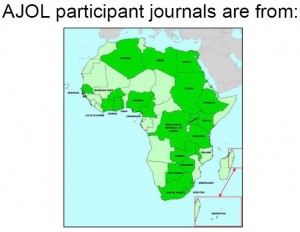
Figure 1a: Distribution of Journals in Africa (used with permission from Ms. Murray)
View Map of Africa in a larger map
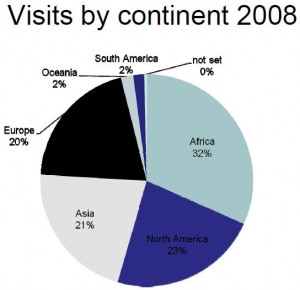
Figure 2: Visits by continent (used with permission from Ms. S. Murray)
(3) Comparison of old and new systems
After the overview and elaboration of the users and stakeholders of AJOL, Ms. Murray went into the details of the AJOL on OJS 2.2.2. She expressed the benefits of such a partnership with PKP led to better upgrading of the system. She found that more advanced versions could also be complied and were easier to upload which allowed for more capabilities in the platform that were not possible before. Figure 3 shows flowchart of the software and resources used ending with final product of the Open Journal Systems coded through the PHP scripting language using MySQL as the database management tool in the APACHE web browser run from the Linux operating system.
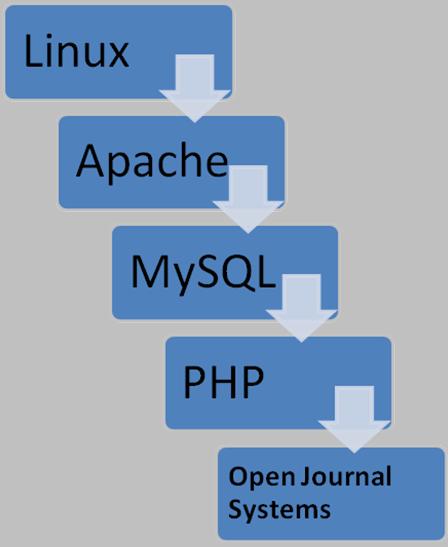
Figure 3: Software and Resources (created by Pam Gill)
A comparison of the new and old system is shown in Figure 4. The new approach is useful for all parties involved and is an excellent search tool with a new look and feel. Currently, as of July 2009, journals now manage their own AJOL pages in terms of the workflow management. In the future, Ms. Murray envisions that journals will be able to host their own versions of OJS on the PKP harvester which acts as a metadata aggregator. The newer versions will include a statistics package and offline plug-ins when connectivity is interrupted. The offline plug-in option will be crucial for users living in remote areas. Eventually, Ms. Murray envisions all journals being independent and managing their own pages.
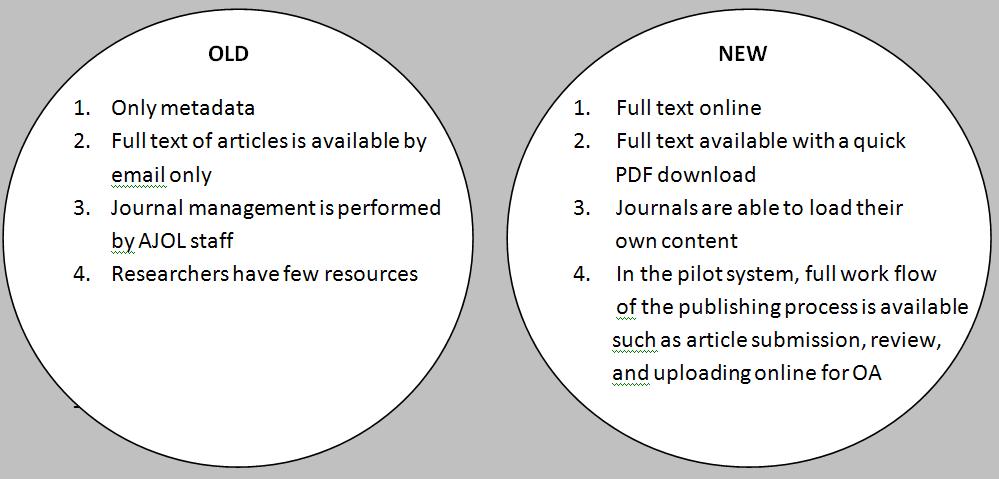
Figure 4: Comparison Chart of Old and New Systems (created by Pam Gill)
To conclude her presentation, Ms. Murray placed great emphasis on the need for the flow of global information from the North to the South (Evans and Reimer, 2009). She stressed the implementation of a new business plan that would allow journals to consider OA as a more viable possibility via AJOL/PKP. The full OJS functionality on AJOL has already made a huge difference as discussed earlier as open source software (OSS) has matured considerably. To summarize Ms. Murray ended her presentation one two key points to promote and continue the dissemination of literature in developing countries. First she brought forth the importance of carefully selecting the best tool that will take into account the needs of the users. Next, she advised to carefully align yourself with partners that you trust and who will support your initiatives for the right reasons. The following quote from Ms. Susan Murray herself summarizes these points:
“Relationships and communication are still the drivers of success, the technological tools are just the vehicle.”
– Susan Murray (2009)
This quote from Ms. Murray is used to illustrate that the technology can help propel the dissemination process in varying capacities. Technology depends on the specifications and limitations of the hardware and software. Yet, at the end of the day, relationships with others are the most important in terms of communicating, working collaboratively sharing ideas, which will ultimately lead to the success (or failure) of your goals and aspirations.
Questions from the audience asked at Ms. Murray’s session:
Question: Is AJOL published in other languages (referring to Figure 1 of African map from Susan’s PowerPoint slide)? Does AJOL have plans to bring more non-English journals to the portal?
Answer: Yes, we are hoping to introduce this to Francophone countries by starting the process of translating to French. So there will be an English/French option. We have a few journals published in Portuguese, Arabic. If we have a journal that is online (and space is NOT a problem) then we can publish in a local, indigenous and international language. Then at the same time research can be read by the local community and broadly by the rest of the world. This will increase readership and the journal will have met the needs to satisfy the best of both worlds.
Related Links
Conference attended by Susan Murray
Software/Sites
- African Journals Online
- OJS 2.2.2 Download
- PKP Open Archives Harvester: free metadata indexing system
References
Evans, J.A, & Reimer, J. (2009). Open Access and Global Participation in Science . Science. 323, 1025
Murray, S. (2009). Open journal systems (OJS) software as used by African journals online (AJOL). PKP Scholarly Publishing Conference 2009. Retrieved 2009-07-09, from http://pkp.sfu.ca/ocs/pkp/index.php/pkp2009/pkp2009/paper/view/216
July 11, 2009 1 Comment
Maximizing the Reach of a Graduate Research Journal Through Open Source Tools and Social Media: The Session Blog
Presenter: Rajendra Bose
July 10th, 2009 at 3:30 p.m.
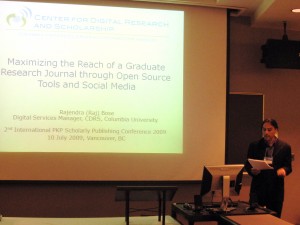
(used with permission from Raj Bose)
Background Info
Cultural Formations is an online journal (due to launch next month) that is open-access and peer-reviewed. The Center for Digital Research and Scholarship (CDRS) collaborated with Columbia University’s Teachers College to form Students for a Cultural Studies Initiative (SCSI). This project has grown to become more than just an online journal, using the concepts of Web 2.0 and Social Media as well as a research repository, Academic Commons.
As quoted on the Cultural Formations website, the journal-plus project has “…three integrated elements: an online journal of peer-reviewed articles, a blog for discussion of published articles and works in progress, and a wiki to serve as a “Wikipedia” of cultural studies and education.”
Session Overview
Graduate students at Columbia University and the Teachers College joined forces to form SCSI. Over the past year, they have worked hard to start a “journal-plus” – an online space that looks at cultural formations including youth culture, media, music, art, film and ethnicity, etc. Their goal is to not only publish research but to be accessible to the entire community, not just academic scholars. Along the way they were faced with significant challenges (examples include web design, technical problems with layout of the vastly different programs and challenges from having multiple partners with decision-making authority). They are however on schedule to launch their site next month. (Please stay tuned to this blog for the launch announcement!)
Services they hope to provide
- Publications – e.g. online books, journals
- Conferences
- Academic Commons
- Wikischolars
An example of what their website will look like:

(Used with permission from Raj Bose)
The goals of the Cultural Formations site are three-fold:
- authority of a journal
- immediacy of a blog
- what’s new and emerging in wiki format
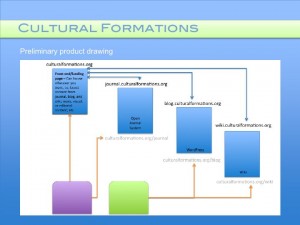
(Used with permission from Raj Bose)
The site is scheduled to launch in August 2009 at Culturalformations.columbia.edu (URL may change prior to launch).
Questions from the audience
1. Impressive. Will you open this up to the public as open source?
Yes, we are using all open access materials. The idea is to share it with the rest of the community, Users may have to connect with us to get a user profile as it may be too expensive to allow it open to all users at once. There likely will be a basic free level, and we may charge for some of the more advanced functions. We feel the site will have longevity with the article content/repository.
2. Is there a similar movement in other universities?
Yes, but the idea right now is to work with university presses and authors right here to get the right agreements.
3. Is there going to be any co-ordination with other groups?
Already there are 50-100 student journals with OJS [Open Journal System]. You especially want this system for longevity when a student group starts to fade out, this will help. The university hosting this site will help keep those groups up and running.
4. What about groups with other levels of education and how this may be used?
This idea is not a typical journal, but the idea to connect a blog and a wiki so that other members of community can join or help is amazing and very inclusive. Because of this, there will only be a light peer review. They partners want to keep this as open as possible.
Related Links
Center for Digital Research and Scholarship (CDRS)

Open Archives Initiative Object Reuse and Exchange (OAI-ORE)
July 10, 2009 Comments Off on Maximizing the Reach of a Graduate Research Journal Through Open Source Tools and Social Media: The Session Blog
Socializing and Disseminating the Academic and Intellectual Creation: Experiences from La Plata National University: The Session Blog
Date: July 10, 2009
Presenters: Gonzalo Villarreal, Marisa Raquel De Giusti

s13610, “Feet” January 27, 2009 via Flickr, Creative Commons Attribution. La Plata has a sandbox for OJS and OCS users to get a "feel" with templates!
Session Overview
This presentation was delivered by Gonzalo in real time through Skype.
Background on La Plata National University (UNLP)
He described UNLP as a major university in Argentina and Latin America. It has more then 90 000 students and 10 000 employees, including staff and administration.
About UNLP:
They produce journal articles, degree essays and theses, multimedia production, books and e-books and other products.
History of Development
In 2003, UNLP launched the Intellectual Creation Dissemination Service, SeDiCi, for 2 purposes:
– to provide authors a means to publish
– to benefit society for all it has invested in the university
The original plan of the university was to receive, digitize, catalog and upload documents to the SeDiCi website, but software was needed. After an extensive worldwide search, the team felt they had to design their own software. Celsius-DL was the answer to complete the service to scholars. It has since been recognized as the OEA’s award in 2005 as the best Digital Library in America.
Celsius-DL supports a free scheme and is used to configure a wide range of materials. It exports to Dublin-Core or Marc21, is a data and service provider and it is built on open source technologies.
Since 2007, UNLP has recognized the importance of disseminating academic and intellectual creations. Journals also were seen as crucial to disseminate, so SeDiCi was expanded to include them. In October, 2008, UNLP launched the Journals Portal. Pre-existing and new publications are both accepted. Authors publish through a review process, easily communicating with other authors, reviewers and editors. OJS was chosen as the platform for them to use.
They then decided to create the Congresses Portal. This helps groups and others organize meetings. PKP’s OCS was selected to supply the service. SeDiCi’s team offers user, systems and technical support to users, but they had to overcome some obstacles and learn how to use it.
Obstacles and Solutions
- Obstacles included many words or phrases in Argentina that were different from Spain. Corrected translations are now complete. In service to others, they are also available on PKP’s website for download.
- In addition, some OCS users needed to use some LaTex in their abstracts. None were available, but they are now available as a plugin.
- Next, the UNLP main website was comfortable for users, so the Journals and Congresses websites have been adjusted to look similarly. A comparison may be seen on-screen to show the similarities.
- Further, templates are available for users uncomfortable with changing them, but wanting to meet their own needs. OCS and OJS is fully customizable by editing a CSS file. Many CSS styles were made for publishers to choose from because not all had web designers to make changes.
- Finally, workshops online have been offered. Users can see an overview to see what the software is capable of and what it won’t do. There are workshops for users and workshops for managers. They have a “sandbox” area where users can try things without affecting the real system.
Note: the voice link with Gonzalo was lost in the last 2 minutes of his presentation. We hope all essential concepts were conveyed.
Blogger’s Thoughts:
The workshops sound tremendously helpful for users and managers. The sandbox feature is very practical and should be of interest to many. A great deal of work has been done to provide leadership in Argentina and its metron of influence. While the audio feed accomplished the task, it would have been good to see them in person to be able to ask questions and benefit from their experience. I was particularly interested in how their design of Celsius-DL provided benefits not found in software as a result of their worldwide search.
In light of the work so many other libraries and institutions are doing to promote the dissemination of scholarly knowledge and research, through either the use of OJS and OCS, one thought seems to echo through the workshops. It is a “cry” for collaboration and communication. From sharing experiences and collaborative problem-solvingj, to establishing some form of index standard are common issues shared by Mexico, the U.K., Canada and others. I hope a leader emerges and this is actualized.
While this is recognized as a technically-themed presentation, I wondered how much use of open journals resulted from their work. While I couldn’t access this information, I was able to view a page on their website that revealed how many “hits” they’ve had at SeDiCi and how many registered users they have. I was surprised that the vast majority originated in the United States! Journal numbers, particularly open journal numbers would be of interest to many at the next conference.
Presentation Link to be provided by conference organizers.
Presenter Links:
Gonzalo Villarreal [The blogger lacked the language to translate, but has listed some found on the SeDiCi repository!]
A Linux publication
Co-authored, in Portugese: Manuscript Character Recognition Overview of features for the Feature Vector
Marisa Raquel De Giusti
Simulation framework for teaching in modeling and simulation areas
Storage of Simulation and Entities History in discrete models
Article by both outlines the history of their work at La Plata in more detail.
Related Links
PrEBi at La Plata National University
July 10, 2009 Comments Off on Socializing and Disseminating the Academic and Intellectual Creation: Experiences from La Plata National University: The Session Blog
Critical Mass is Critical – Creating Sustainable Scholarly Communication: The Session Blog
When: Friday, July 10, 2009 2pm – 3pm
Room: Main Concourse – Fletcher Challenge Room 1900
Presenter: Gregg Gordon
Gregg Gordon is President and CEO of the Social Science Research Network (SSRN). SSRN is a digital repository that has close to 100,000 full-text documents. The network allows readers access to full text and articles without any changes, but no access to the meta data attached to the articles. It has received approximately 30 million downloads so far. SSRN is part of the social networking community through a blog, Facebook, and Twitter.
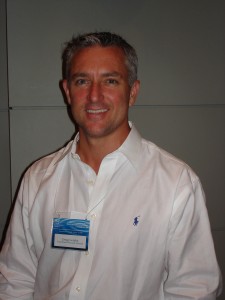
Gregg Gordon (Source: Photo taken by Helen Szeto)
Session Overview:
Gordon’s presentation is about the growing amount of scholarly information that is out there and the connections that can be made with it. He starts off by defining the term “critical mass.” Critical mass is the minimum amount of something required to start or maintain a venture. Gordon believes that there is an endless abundance of information out there. There is a lot of research, but he asks the question, how can academics sort through everything? The biggest complaint received at the SSRN is that there is too much information with over 1000 journals available on the network.

(Source: slide courtesy of Gregg Gordon)
Gordon explains how the scholarship of information is growing. The Open Journal System (OJS) has enabled the creation of over 3000 OJS journals, which means over 3000 new publishers. Every 20 years, the amount of scholarly journals available is doubled. Ninety percent of all scientists are alive today, which means they are still making contributions to the scholarly world. The amount of research available increases because readers are getting access to earlier research stages. In the SSRN, 13% of the citations are towards working papers. Drafts are being referenced. Interdisciplinary classifications are also increasing research relevance. Academics are able to see the content from a broader amount of subjects.

(Source: slide courtesy of Gregg Gordon)

Gregg Gordon Presentation (Source: Photo taken by Helen Szeto)
Gordon says that traditional publishing models are slowing innovation. On the other hand, clusters of information are increasing innovation. Information is being connected to make more meaningful relationships. People are growing up with access to information and therefore understand that information needs to be free. Depositories are being built, but not used widely. Greg offers a formula to get people to the depositories. “C(onversation) + C(onnections) = C(ommunity)” Communities will form when people are talking about the information out there and making connections with the pieces. Gordon says as you find more content, you determine what is important to you. The community also has to provide many means to access the information. Content is being accessed through the web and various social networking sites. Wireless allows information to be accessible anywhere and everywhere.

Clusters and Connections of Relevant Information (Source: slide courtesy of Gregg Gordon)
In Gordon’s search trend analysis, he has discovered that people are looking at blogs and wikis to find what is important to them. Journal use has declined a little bit in trend. Gordon makes a reference to a NY Times article regarding Google search being replaced by YouTube in an elementary school.
The overall underlying message is that communities are key to sharing ideas and making relevant connections in your field of study.
Session Analysis:
Gordon makes good use of visual slides to display his ideas of growing information and the communities that emerge from the connections being made. By visually being able to see the clusters of information and the connections they form, we have a better understanding of their impact. Gordon has shown that repositories will be more efficiently used when the information is clustered and networks are created. We learn that communication is vital in grouping relevant research together. People need to have discussions and to share their ideas in the communities. Gordon is showing us how we can make better use of the information mass that is already out there.
Session Questions and Answers:
1) Why is there more structure in the scholarly publishing of hard sciences than in the social sciences?
Reply: Gordon compares scientific, technical and medical (STM) publishing and social sciences to a rifle shot and a shotgun approach. STM is like a rifle shot where information is very cloistered. “Social sciences have a shotgun approach because you want to get your information out there by getting published. In the hard sciences, you are writing to fund your lab, while in the social sciences; you are writing to build your lab.” There are two clear differences in submission approaches. “Some academics do not want to submit anything until it is it ready, while others will send out a proposal to put their stake out there.”
2) Gordon also comments that there needs to be a person checking the data to ensure that quality is there.
Related Links
- Social Science Research Network (SSRN)
- PKP 2007 – Creating Scholarly Communities and Fostering Innovation (presentation by Gregg Gordon)
- Critical Mass is Critical, Building Authority in a Changing World (under Feb 6, 2009 – video of G. Gordon’s presentation)
- Bepress: The Other Legal Repository
- An Interview with SSRN’s Gregg Gordon
July 10, 2009 Comments Off on Critical Mass is Critical – Creating Sustainable Scholarly Communication: The Session Blog
Building content and community: digital publishing services at the University of Kansas: The Session Blog
July 10th, 2009 at 2:30pm
Presenters: Brian Rosenblum and Scott Hanrath
Background
 (Source)
(Source)
Contact: brianlee@ku.edu
Brian Rosenblum is Scholarly Digital Initiatives Librarian at the University of Kansas Libraries, where he has administrative, production and outreach responsibilities in support of a variety of digital initiatives and scholarly communication activities, including KU’s institutional repository and digital publishing services. Prior to joining the Kansas digital initiatives program in 2005, Brian worked at the Scholarly Publishing Office at the University Library, University of Michigan, where he helped develop numerous electronic journals and digital scholarly projects.

Session Overview
Brian Rosenblum outlined that in 2006 the University of Kansas (KU) library looked at new roles to support scholarship on campus. A survey was undertaken to determine campus needs. The university comprises some 28,000 students and 2,300 faculty.
Initially it was hard to ascertain which journals were asscociated with faculty research. The library is still encountering new journal activities. Local journal editors were interviewed to discuss needs, and a forum was formed to build relationships with editors.
New roles for the library included stewardship of scholarship production at Kansas, as well as working directly with faculty in terms of metadata tools and tagging systems. A mandate was established for the digital publishing services, including supporting faculty in all forms of digital publishing, exploring new publishing models, and promoting increased visibility and access. In 2005 the KU Scholarworks Repository was launched; however this does not have author submission or peer review tools that OJS has.
Rosenblum gave some examples of KU digital publishing. The Biodiversity Informatics journal was launched by a single professor using OJS. This would not have been possible within the standard printing process. Several journals are available as back issues online (subject to a 3 year lag), enabling much wider access, of particular relevance to South America. Other journals are in traditional print, but also available online with immediate access. Rosenblum showed some download statistics, but these are coarse measures at present, needing more informatics for detailed records.
KU is the first public US university to have an open access research policy, announced in June 2009.
Scott Hanrath, as technical lead, outlined the technical aspects of digital publishing at KU. Technical roles have been split up between different departments, so there is a need for careful communication , planning, and identification of who does what. Customization of OJS has been mainly cosmetic, altering the look and feel of sites. Un-needed options have been stripped out. IT support staff have created the ‘KUdifier’ plug-in to personalize OJS. For the import process it’s been found to be better to work in smaller chunks, either 2 – 4 years of a journal or less than 400 articles at a time.
Rosenblum outlined the following points for the future: a more sustainable workflow, a need to outline the value of this service (especially in the light of budgetary cuts), improved OJS training, editorial advisory board meetings, and hosting a larger editors’ forum.
Question
A member of the audience asked about the process that led to the university adopting open access. Rosenblum replied that the tenured librarians encouraged the initiative to originate from the education department. There was a small, but vocal opposition. A visit from John Willinsky for consultation in February encouraged the process. The motion was passed with 22 in favour, and one abstention.
Resources
Brian Rosenblum Scientific Commons
July 10, 2009 Comments Off on Building content and community: digital publishing services at the University of Kansas: The Session Blog
Making a University Library a Real Support for Research Dissemination: The Contribution of OJS and OCS: The Session Blog
Date: July 8, 2009
Presenter: Sely M.S. Costa, University of Brasilia
- Senior Lecturer, Department of Information Science
- Chief Librarian, Central University Library, University of Brasilia-DF
Interests: scholarly communication, open access, electronic publishing, institutional repositories, organisation communication, and information science theory.
Abstract
Session Overview

Sely Costa PKP2009, with permission
Presentation:
Powerpoint provided by Sely Costa
As Chief Librarian, she has started many projects to use a number of different programs to support research dissemination. Repositories now offer a simple step in the publishing process for librarians. The role of librarian has changed to become a more active participant in scholarly publication process. She works with journals, books, conferences, learning, articles, proceedings, and learning objects. They use OJS and have begun publishing. They have a project with a repository that is still in development. They have tested the use of OCS for conferences. It is under discussion for inclusion in the library system of Information Policies, Information Units and Information Services and Products. The draft of their Open Access policy is also under discussion.
PKP offers help in Conference Organizing and Proceedings, as well as e-books and e-journal publishing. They will update to the OJS Suite when it is possible. OCS has been used for both international and national conferences, has worked well and has been well received.
As librarian, her role is to highlight the new roles of these technologies. Librarians are major actors in the scholarly communication process. The University library is an essential element in the scholarly communication system.
They are the first academic library to be able to help others run conferences, etc. There is some resistance to OJS in Brazil, but the researchers at her university are in full support of it. Understanding the process makes all the difference. The activities done by the libraries now make them essential in the process.
Concluding Discussion and Questions:
(shared between Sely Costa, Brazil and the preceding workshop presenter Alberto Apollaro, Argentina)
1. <Question not heard> Sely: We are doing a project investigating over 700 uses of OJS use. People are not aware of the business models that need to be defined, nor are they aware of defining the strategic access policies to consider before creating a journal. You work with journals that already exist…but, who looks after this for CONICET? Sely: CONICET itself. We are thinking of using OJS to create journals from scratch, but we do not have clear policies of access and we need to define these policies. (See blogger’s Links of Interest near the bottom of the page)
2. (To Alberto Apollaro, Argentina ) Have you had 10 journals that have gone through the review process? Not yet. We are in the information stage with the journals. But there are journals interested in this? Yes. Comment from attendees: Libraries have lost a lot of their power, but with technologies, they are gaining new popularity. The universities are very fond of PKP software. I assume SciELO was a digital library and not a publishing agent. Sely: Yes. We think not all our publications will be in SciELO, so we need to create another collection. In the end, we need to create a bridge between SciELO and this website.
3. Sely, how do you work with your University Press, because it sounds like there could be some synergies there. (Answer summarized) We just changed our administrator. I offered to create a digital journal. He is concerned about losing subscribers. I need to talk to him about this. We have 6 or 7 African countries who speak Portugese, so if we can have these journals available for access, it is great for our university. We have Master’s dissertations that have had many, many downloads. I am a researcher and a librarian and I know what a researcher needs from the library. PKP has really helped me.
4. How do you see this playing out at other university libraries in Brazil? There are already some libraries doing it. I call myself the Open Access Evangelist. I feel so good that I have been able to influence people in my country.
Links of Interest:
CONICET is the Argentinian government agency established to organize and direct research that is publicly funded.
CONICET also has been listed on an open source portfolio (OSP) site, called OpenEd Practices, that uses SAKAI, an environment that complements the OSP software. No contributions appear from CONICET to date.
SciELO is a scientific, electronic, online library containing selected Brazilian journals.
July 10, 2009 Comments Off on Making a University Library a Real Support for Research Dissemination: The Contribution of OJS and OCS: The Session Blog
Implementing open access in agricultural research: the experience of the Brazilian Agricultural Research Corporation
Session: Implementing open access in agricultural research: the experience of the Brazilian Agricultural Research Corporation
Presenter: Patricia Rocha Bello Bertin
Background: The Brazilian Agricultural Research Corporation‘s (Embrapa) mission is to provide feasible solutions for the sustainable development of Brazilian agribusiness through knowledge and technology generation and transfer. Read more here.
Overview
Embrapa is a governmental organization that is 36 years old, has 38 research units, 3 service units, 13 central divisions and works in every Brazilian state. Their mission is to provide feasible solutions for the sustainable development of Brazilian agribusiness through knowledge and technology generation and transfer.
As background context, agricultural science is one of the most important Brazilian contributions to global scientific production (4% of global production). Research outputs are dispersed worldwide and there is poor research assessment tools, resulting in low visibility. Embrapa is a prolific publisher, producing 67,916 articles in total from 2000-2007.
Embrapa has an open access project, whose objective is “to propose and implement a model for scientific information management based on open access statements and policies”. They make available both their internal data providers (e.g. institutional repository, institutional electronic journals) and external data to the public. Embrapa’s five scientific journals have never followed the business model of large publishers so were well suited to the open access model. The Brazilian Journal of Agricultural Research’s first electronic version was created in 1997. Recently, the OJS has been asked to solve other institutional needs and is focusing on that.
Institutional Repository: They have developed a number of systems for scientific information organization and retrieval. They had identified a need to integrate processes and technological platforms. A system was developed for capturing all scientific production available in the 39 homepages of Embrapa’s Research Units and automatically adds them into the institutional repository (6,400+ items).
An example of one of their systems is Ainfo, a system for librarians’ management used to monitor the Research Units’ scientific production and the researchers’ progress in improving their scientific production. The Ainfo integration into the respository was found to be strategic for the success of the Open Access implementation, since the obligation of evidencing the scientific production already has a policy of compulsory deposit. Another example is an experimental installation of DSpace (1.5.2 version) wth access restricted to internal user.
The Open Access mandate policy benefits form instituional policies which obligate the researcher to communicate and proove scientific production, and simultaneously benefits the organization to be sharing this knowledge.
The Tech Side
Service provider building: Open source metadata harvesting tools’ evaluation (PKP Metadata Harvester, MOD AI, OAI Harvester, OAI Arc, JOAI Harvester, and OAI Harvester OCKC. Aspects considered include update and availability of new versions, the web interface fo rdata collection, the users interface for searching, the documentation support offered for setting and installating the metadta collection tool. To date, they have identified 261 data providers of interest to Embrapa.

Analysis / Issues / Reactions
The focus of the presentation seemed to be on the establishment of the system and what it offers, rather than on how it is used by those outside of Embrapa. I was curious to know, as a way of judging the utility of these efforts and what they might offer as a model for other similar specialist research institutions, what the take-up has been from the public and specifically, from a non-academic audience (e.g. is there anything that farmers access and use? extension workers? NGO staff?)
In terms of an international dissemination that could make the research coming from a specialist, innovative research organization accessible to other development countries, language access is an issue. The public site is in English, Spanish and Portuguese and it appears that the English site is slightly more limited than the Portuguese versions.
Despite these issues, the profiling of this initiative offers a potential model of how a large governmental body can innovate integrated platforms by which to share its knowledge and tools with a broader audience in a more equitable fashion.

(source)
July 10, 2009 Comments Off on Implementing open access in agricultural research: the experience of the Brazilian Agricultural Research Corporation